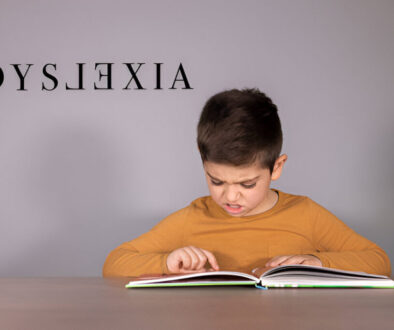
Is Writing Backwards a Sign of Dyslexia?
Dyslexia is a learning difference that affects how people process written language. One common question parents and teachers ask is whether writing letters backwards or reading words backwards are signs of dyslexia. At Cook Vision Therapy, we’re here to clarify what these behaviors mean and how they relate to dyslexia.
Wondering if your child’s backward writing signals dyslexia? Common in early learners, but persistent reversals may need expert evaluation. Learn the signs and when to act.Key Takeaways: Dyslexia & Letter Reversals
- Normal Development:
- Occasional letter reversals (e.g., “b”/“d”) are common in children under age 7 and usually resolve over time.
- Red Flags for Dyslexia:
- Persistent reversals past age 8, paired with:
- Slow reading, poor spelling, difficulty decoding words.
- Trouble rhyming, blending sounds (e.g., “c-a-t” → “cat”), or avoiding reading tasks.
- Persistent reversals past age 8, paired with:
- Diagnosis & Action:
- Requires professional evaluation (educational psychologist, vision therapist) to assess reading fluency, phonemic awareness, and visual processing.
- Early intervention (structured literacy programs, accommodations) improves outcomes.
- Parent Steps:
- Track reversals and reading struggles for 3 months.
- Consult specialists to rule out sensory issues and assess learning needs.
- Advocate for school accommodations (IEP/504 plans, audiobooks, extra time).
- Vision Therapy:
- Enhances visual skills (eye tracking, focus) but doesn’t cure dyslexia. Complements language-based interventions.
- Normal vs. Dyslexia:
- Typical: Self-corrects errors, no avoidance of reading.
- Concerning: Persistent reversals + emotional distress (e.g., anxiety, calling themselves “dumb”).
Understanding Dyslexia: Key Signs Beyond Letter Reversal
Dyslexia impacts how the brain processes written language. While letter reversal (e.g., confusing “b” and “d”) is common in children under 7, persistent issues may signal dyslexia. Key signs include:
- Difficulty decoding words
- Slow reading pace
- Poor spelling and phonics skills
Is Writing Letters Backwards a Sign of Dyslexia?
Writing letters backwards, like confusing “b” and “d” or “p” and “q,” is often associated with dyslexia. However, it’s important to note that letter reversal is common in young children learning to write. Many children reverse letters as they learn to read and write, and this behavior can continue up to the age of 7 without being a cause for concern.
When Is It a Sign of Dyslexia?
If a child continues writing letters backwards beyond the early stages of learning to read and write, it might be a sign of dyslexia. Dyslexia is not caused by vision problems but by the way the brain processes written language. If your child is reversing letters and having trouble with reading, it’s a good idea to consult an eye doctor or specialist for an evaluation.
Why Do People with Dyslexia Read Words Backwards?
Reading words backwards isn’t common, but some children with dyslexia might try reading from right to left as a strategy to decode text. Dyslexia often involves difficulty in recognizing and processing the order of letters in words, which can lead to reversing the letters in the mind. This doesn’t mean seeing the word in reverse, but rather misinterpreting the sequence of letters.
Dyslexia and Reversing Letters: A Processing Disorder
Dyslexia is a processing disorder that affects the brain’s ability to recognize and organize written language. When a child reads or writes letters backwards, it’s often a sign that they’re struggling with the directionality of letters—understanding that we read and write from left to right. This is why letter reversals are a common sign of dyslexia.
Letter Reversal and Dyslexia: What You Should Know
It’s important to understand that letter reversal is just one sign of dyslexia, and not every child who reverses letters has the disorder. Dyslexia involves a range of symptoms, including difficulty with phonics, decoding words, and reading fluently. If you notice that your child is reversing letters and showing other signs of dyslexia, like trouble with reading comprehension or a slow reading pace, it may be time for a professional assessment.
Vision Therapy for Dyslexia: How It Helps
While dyslexia is not caused by vision problems, vision therapy can support children with dyslexia by improving their visual processing skills. Vision therapy focuses on enhancing eye movement control, focusing abilities, and visual perception, which can help children better understand and process the words they see.
Success Stories: Overcoming Dyslexia and Letter Reversal
Many children with dyslexia and letter reversal challenges have found success through specialized teaching methods, multisensory learning, and tools like vision therapy. These methods help children learn to read and write more effectively by engaging multiple senses, such as sight, sound, and touch, to reinforce learning. Read our review.
Vision Therapy for Dyslexia: How It Helps
Though not a dyslexia cure, vision therapy strengthens visual processing skills critical for reading:
- Eye movement control
- Focus and tracking
- Spatial awareness
Accommodations for Students with Dyslexia
For students with dyslexia, certain accommodations can make a big difference. These may include extra time on tests, the use of audiobooks, or having access to word processors for writing assignments. These tools help children with dyslexia succeed in the classroom, despite the challenges they face with reading and writing.
The Sooner You Address Dyslexia, the Better
Early detection and intervention are key to helping children with dyslexia. The sooner you address the signs, like letter reversal and reading difficulties, the sooner your child can get the support they need. If you suspect your child may have dyslexia, consider scheduling an eye exam or a consultation with a specialist to explore your options.
Dyslexia Diagnosis: Beyond Writing Backwards
A comprehensive evaluation assesses:
- Phonemic awareness
- Reading fluency
- Comprehension
- Family history of learning disorders
Early intervention improves outcomes. Seek an assessment if your child struggles beyond age.
Parent Action Plan: Steps to Support Your Child
If you suspect dyslexia or ongoing letter reversals, follow this actionable plan to advocate for your child:
-
Track Behaviors
-
Keep a 3-month journal of letter reversals, reading struggles, and emotional reactions (e.g., avoidance of homework).
-
Note patterns: Does your child confuse similar-looking words like “was” and “saw”?
-
-
Consult Specialists
-
Pediatrician: Rule out hearing/vision issues.
-
Educational Psychologist: Request a dyslexia screening.
-
Vision Therapist: Assess eye tracking and visual processing (even if eyesight is 20/20).
-
-
Collaborate with the School
-
Share your observations with teachers.
-
Request a formal evaluation for an IEP (Individualized Education Program) or 504 plan.
-
-
Implement Home Strategies
-
Use multisensory tools: Sandpaper letters, phonics apps, or colored overlays for reading.
-
Praise effort over accuracy to reduce frustration.
-
-
Follow Up
-
Reassess progress every 6 months. Adjust interventions as needed.
-
How Vision Therapy Complements Dyslexia Interventions
While dyslexia is a language-processing disorder, vision therapy strengthens visual skills critical for reading success:
-
Eye Tracking: Smooth left-to-right movement reduces line-skipping or word omissions.
-
Visual Memory: Improves recall of letter shapes (e.g., differentiating “b” from “d”).
-
Focus & Coordination: Helps eyes work together to reduce fatigue during reading.
Example of Integration:
A child with dyslexia might work with a reading specialist on phonics while attending vision therapy sessions to address eye teaming issues. Combined, these approaches tackle both language and visual barriers to learning.
Vision therapy doesn’t replace dyslexia-specific tutoring but enhances its effectiveness. Think of it as “glasses for the brain’s visual system.”
Steps to Take If You Suspect Dyslexia
-
Observe Early Signs
-
Difficulty rhyming (e.g., “cat” vs. “bat”)
-
Struggles with letter-sound matching (phonics)
-
Avoidance of reading aloud
-
-
Document Concerns
-
Save writing samples with frequent reversals (e.g., “dig” written as “gib”).
-
Record reading sessions to highlight slow pace or guessing words.
-
-
Seek Professional Evaluations
-
School: Request a free evaluation under the IDEA Act.
-
Private Specialists: For faster results, consider a neuropsychologist or dyslexia tutor.
-
-
Explore Interventions
-
Structured Literacy Programs: Orton-Gillingham or Wilson Reading System.
-
Technology: Text-to-speech tools like Learning Ally.
-
-
Stay Proactive
-
Join parent advocacy groups (e.g., Decoding Dyslexia).
-
Share the International Dyslexia Association’s resources with teachers.
-
Normal Development vs. Dyslexia: Key Differences
Typical Letter Reversal (Ages 4–7):
-
Reversals are occasional and decrease over time.
-
The child self-corrects errors when prompted (e.g., “Wait, that’s a ‘b,’ not a ‘d’!”).
-
No avoidance of reading/writing tasks.
Potential Dyslexia Indicators:
-
Reversals persist past age 8, even with practice.
-
Paired with other red flags: Trouble blending sounds (e.g., “c-a-t” = “cat”), slow reading speed, or guessing words based on first letters.
-
Emotional signs: Anxiety about school, calling themselves “dumb.”
Why It Matters:
Dyslexia is more than letter confusion—it’s a pattern of language struggles. Early diagnosis ensures access to accommodations like extended test time or audiobooks.
Key Takeaways on Dyslexia and Letter Reversals
Writing letters backwards and reading words backwards can be signs of dyslexia, but they are not definitive indicators on their own. Dyslexia is a complex learning disorder requiring a comprehensive diagnosis and treatment approach. At Cook Vision Therapy, we’re committed to helping children with dyslexia improve their reading skills and overcome the challenges they face. If you’re concerned about your child’s reading and writing, don’t hesitate to reach out for guidance and support.
FAQs: Dyslexia & Letter Reversals
-
What are signs of dyslexia besides writing letters backward?
Key signs include trouble decoding words, slow reading, poor spelling, and difficulty rhyming. Persistent letter reversals after age 7, paired with these issues, warrant a professional evaluation.
-
When should I worry about my child reversing letters?
-
How is dyslexia diagnosed?
-
Why do kids with dyslexia reverse letters?
-
Will vision therapy cure dyslexia?
-
Where can I get help for suspected dyslexia?
-
Can dyslexia be outgrown?
-
Are letter reversals a sign of ADHD?
-
How do schools test for dyslexia?



